I have been struggling to find the best way to connect a stereo headphones output (the socket where you would normally plug your headphones into) to a Lenovo G575 laptop microphone input for recording. I have tried various methods and got terrible wavy distortion even though the level was set correctly and there was no clipping. The laptop sound card does not have the option of converting the microphone input to an auxiliary input. I tried the suggestion of connecting each stereo channel to a 330 ohm resister in series with a 1 micro farad capacitor which are wired to the laptop mic input (ring and tip wired together) but am getting the wavy distortion.
I also tried adding a 1k resistance to this after the capacitors and also tested with 22K but get the same wavy distortion even when the level is set correctly. The distortion is hard to describe. Its not clipping. Its more like getting louder and softer as if someone is waving a microphone.
I note the resistance of a typical laptop microphone is 1K. I think the solution must lie in getting the correct resistance bridge set up. Your advice would be appreciated.

Best Answer
Speaker levels are in the ballpark of VOLTs and Microphone levels are in the order of millivolts .There are only a few exceptions to this generalisation that are unlikely on a laptop.So whatever you do with resistors lots of attenuation is needed ,why not start with an attenuation factor of 100 and use your capacitors to block DC keeping frequency response flat.If all this doesnt work well after optimising the attenuation factor you could use more caps to lowpass filter at say 16KHZ just in case the laptop speaker output is full of HF crud that you cant hear but could be mucking up the microphone input .Another possibility is ground loop ,noise issues.If you place an audio transformer in your circuit and the problem goes away then you know .proving this can be done with any junkbox audio transformer .Then you can do it properly with good transformer OR diff amp stage.